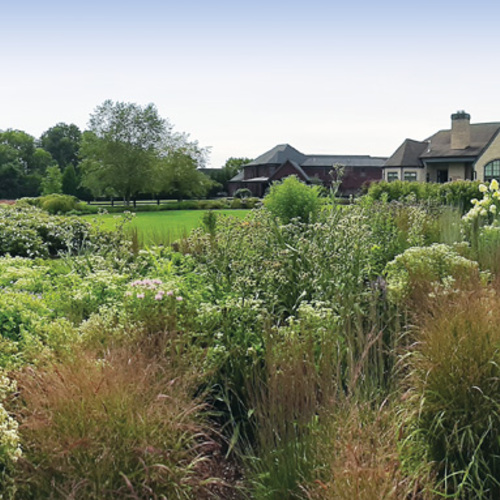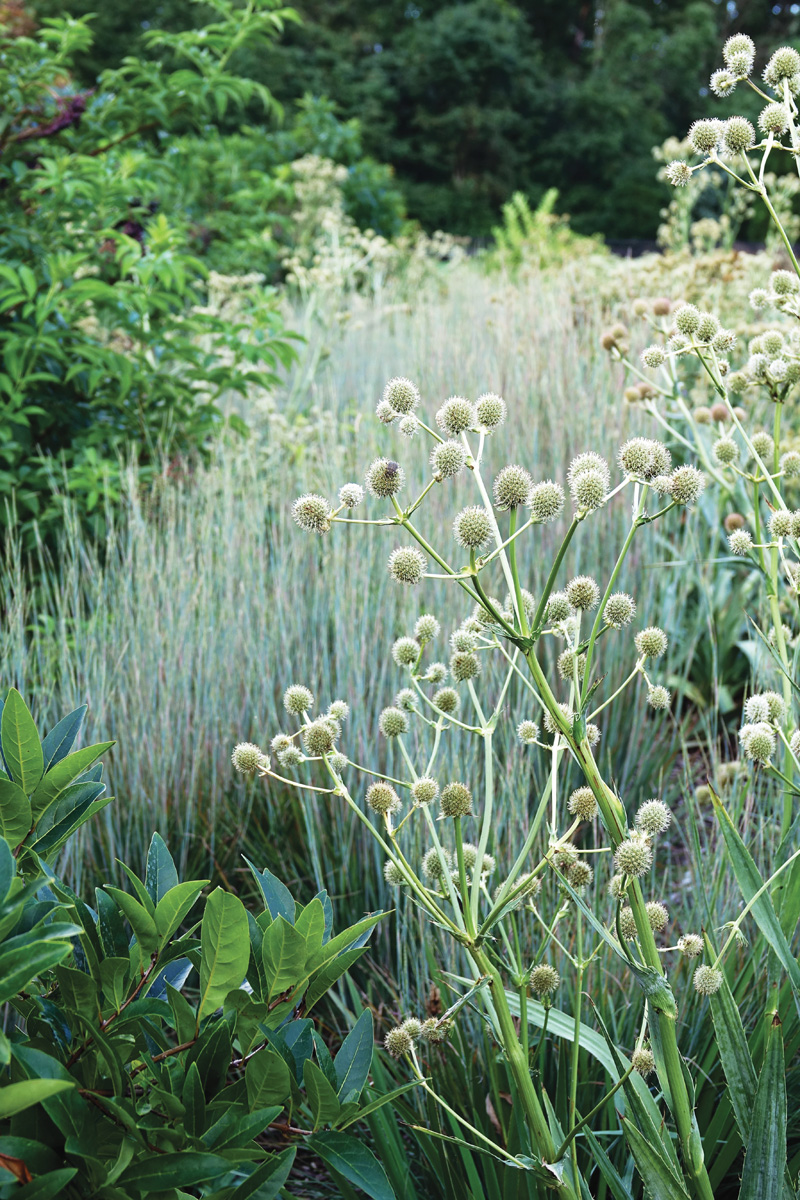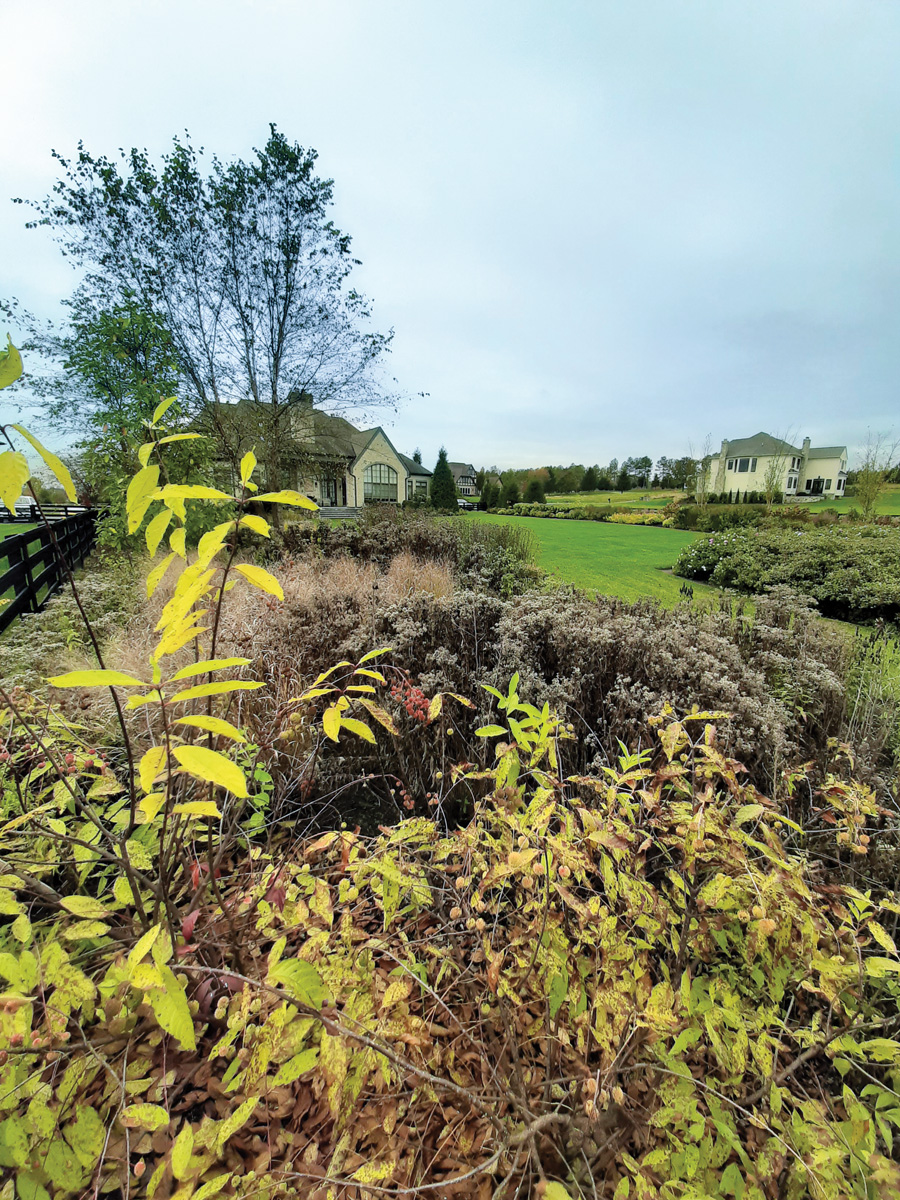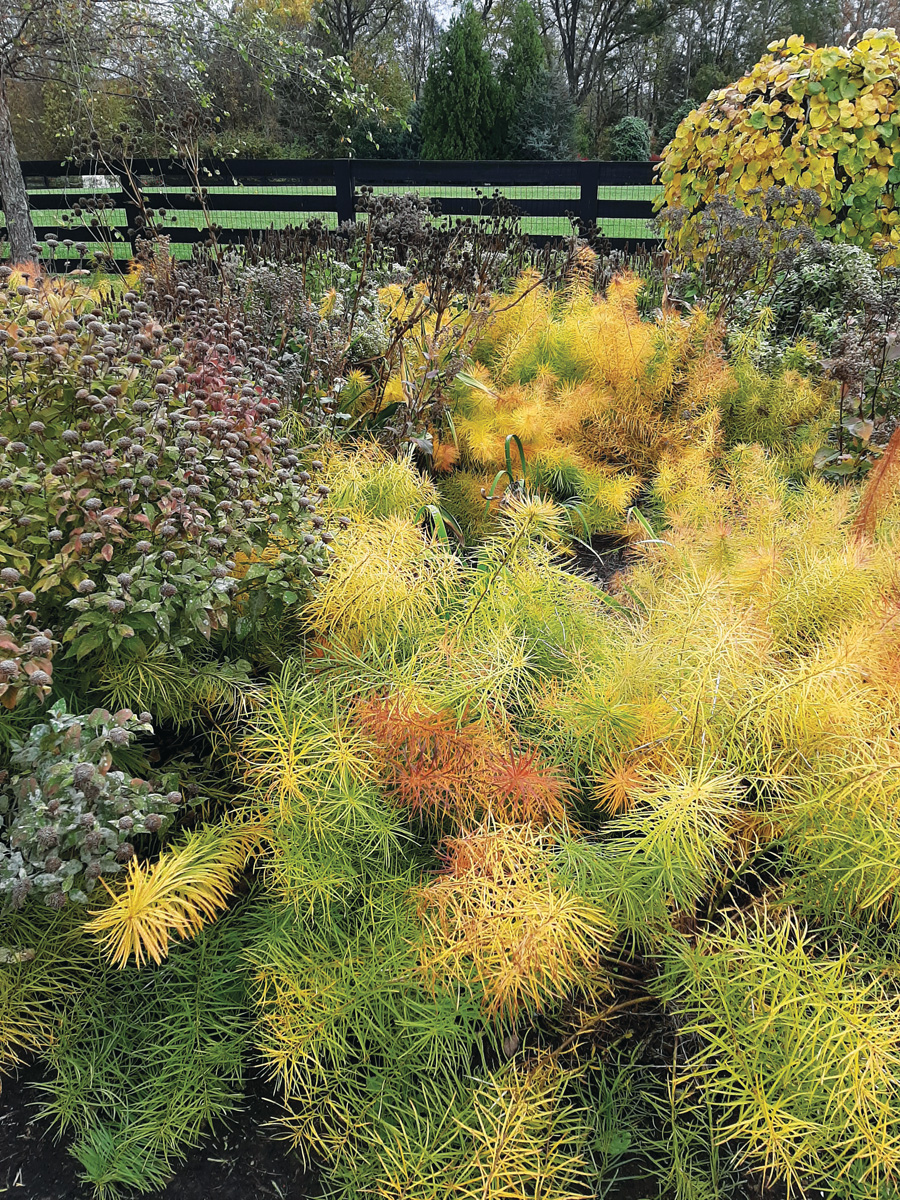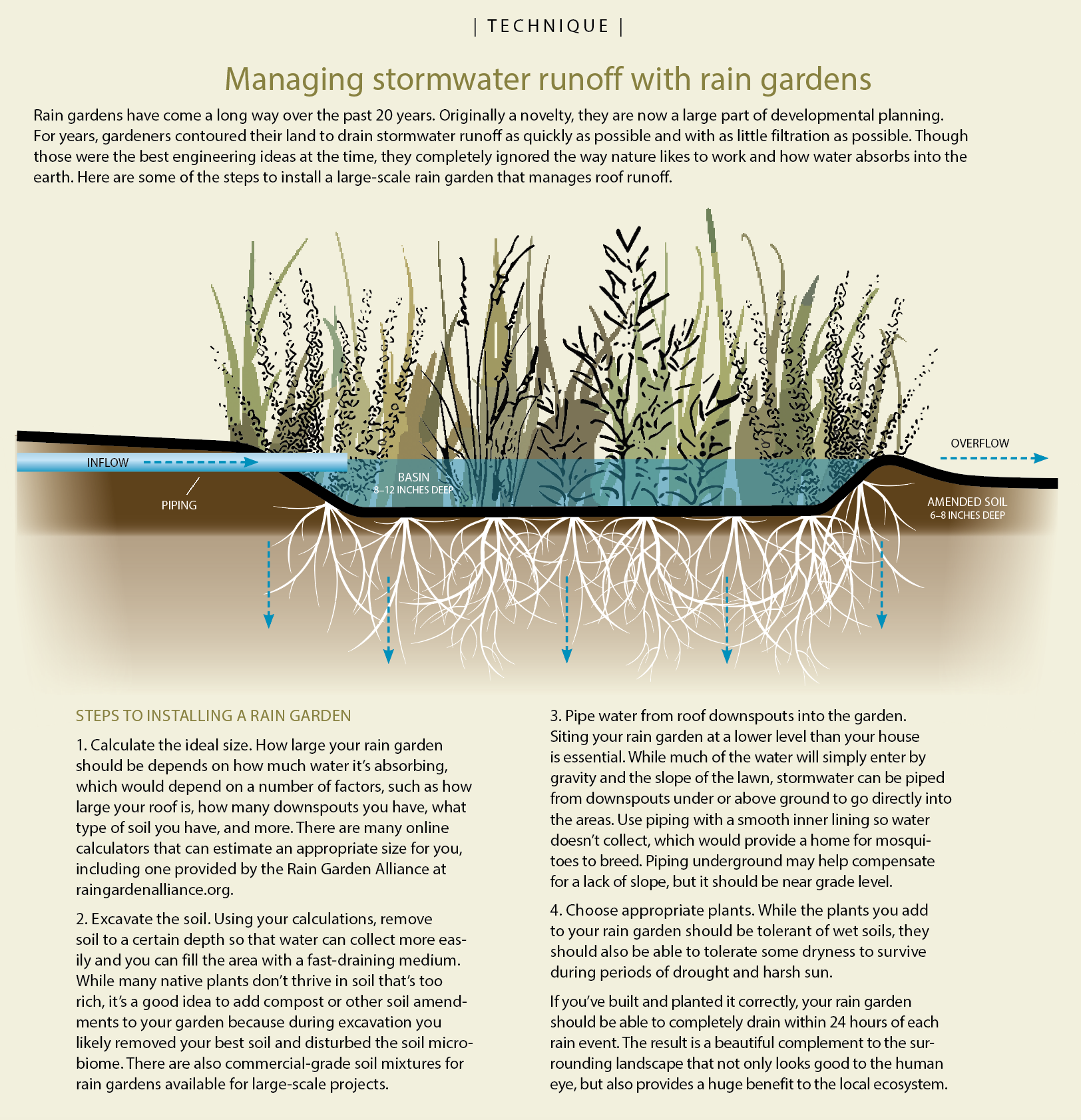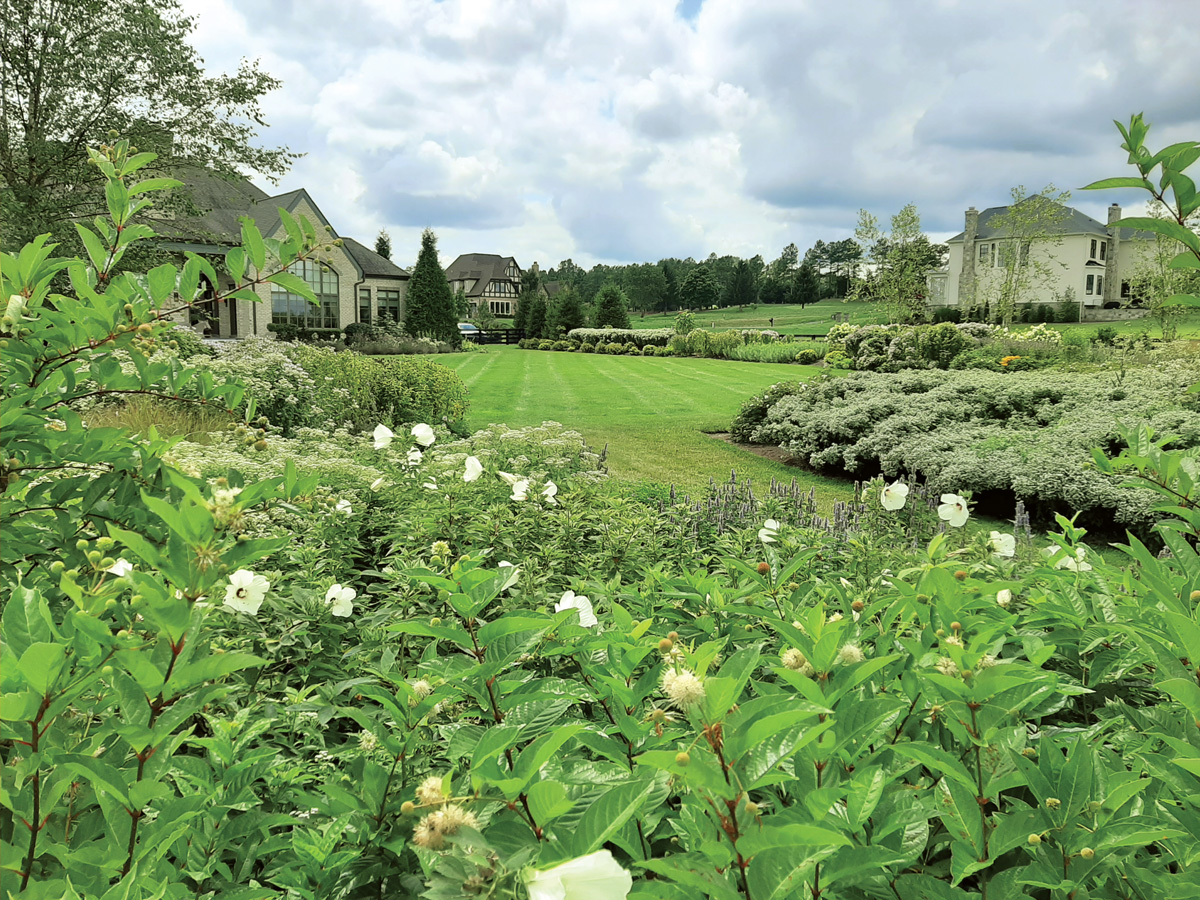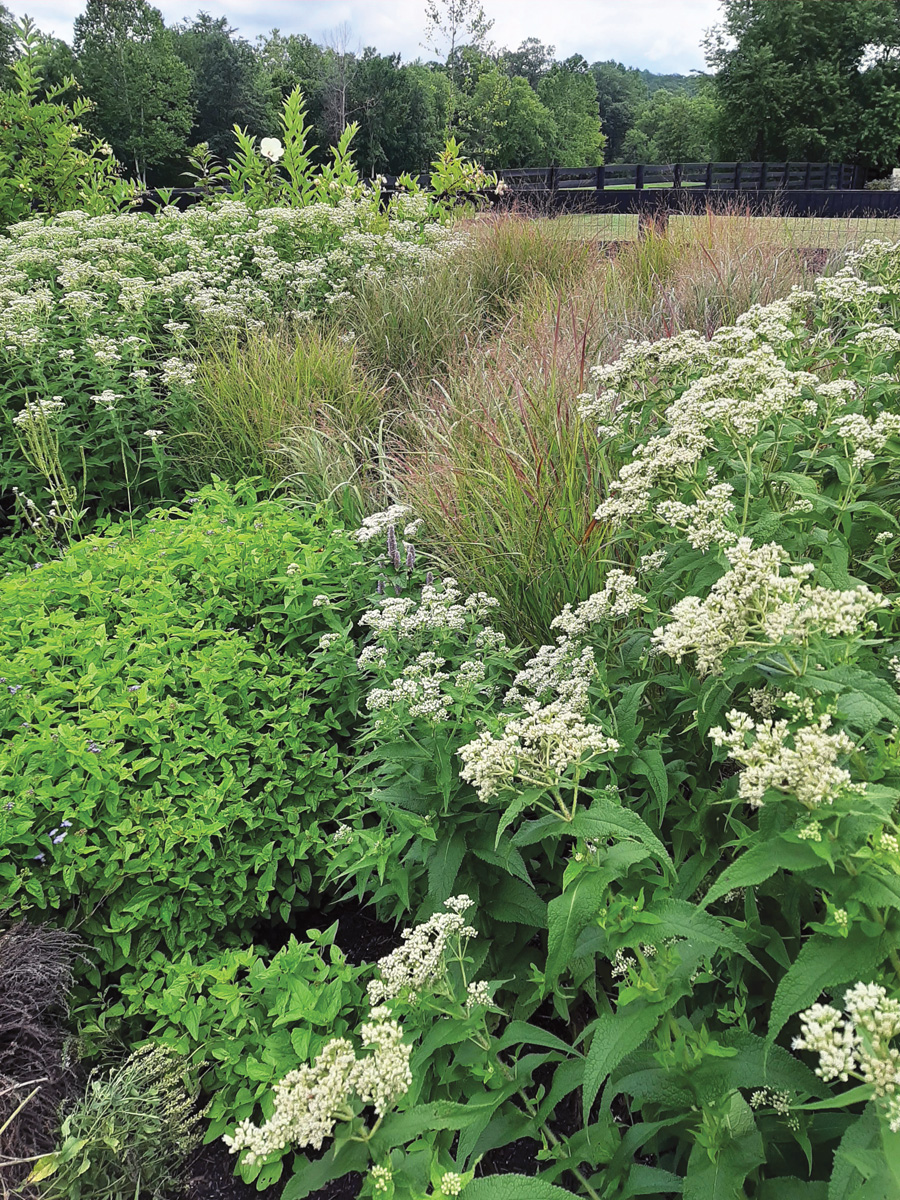As a landscape designer, I’m well accustomed to a challenge. So I wasn’t too worried when the homeowner of a property in Aldie, Virginia, gave me a seemingly straightforward mandate: she wanted a pollinator garden. An easy request, right? Not quite. I was asked to create a more formal design with a “unique look” that matched the upscale home and surrounding neighborhood, which is far different than a messy meadow with loudly colored wildflowers. I had to embrace a limited palette of colors consisting of only green, blue, purple, and white. Additionally, allowing for privacy from a golf course that abutted the backyard was an absolute must, as was managing stormwater to minimize runoff in this lawn-heavy area. This would by far be one of the most challenging projects I had taken on, as this garden needed to be transformed from a mostly barren space dominated by a few typical non-native landscape staples like spirea (Spiraea spp. and cvs., Zones 3–9) and liriope (Liriope spp. and cvs., Zones 6–11) into an environmentally sustainable pollinator paradise. At the same time, this space needed to provide interest during fall and winter when many of the perennials had faded. The result was something truly different from what one would think of when picturing a traditional pollinator garden—a backyard privacy border with berms of native plants that still provides enormous ecological value, which is underscored by the inclusion of two large rain gardens that manage stormwater runoff.
Select pollinator-friendly native plants that thrive in tough conditions
“The right plant for the right place” is a phrase you hear a lot in horticulture, but you should also consider the right plant for the right pollinator. Nearly seventy species of pollinator-friendly native plants were chosen for this garden and arranged in matrix plantings, not only for their wildlife value but for their ability to adapt to the specific challenges of the site: heavy clay soil, hot and humid summers, and a few very moist areas. These different microclimates had to be dealt with accordingly. On the drier berms, combinations like rattlesnake master (Eryngium yuccifolium, Zones 3–8) and ‘Standing Ovation’ little bluestem (Schizachyrium scoparium ‘Standing Ovation’, Zones 4–9) thrived (photo p. 61, top right); and in spots where we’d established rain gardens, a selection of swamp rose mallow varieties (Hibiscus moscheutos cvs., Zones 5–9), switchgrass (Panicum virgatum, Zones 5–9), buttonbush (Cephalanthus occidentalis Zones 4–10), and blue mistflower (Conoclinium coelestinum, Zones 5–9) helped soak up runoff (photo p. 65, top). These plants not only attract threatened native pollinator species with their nectar, but many also serve as host plants for butterfly and moth larvae.
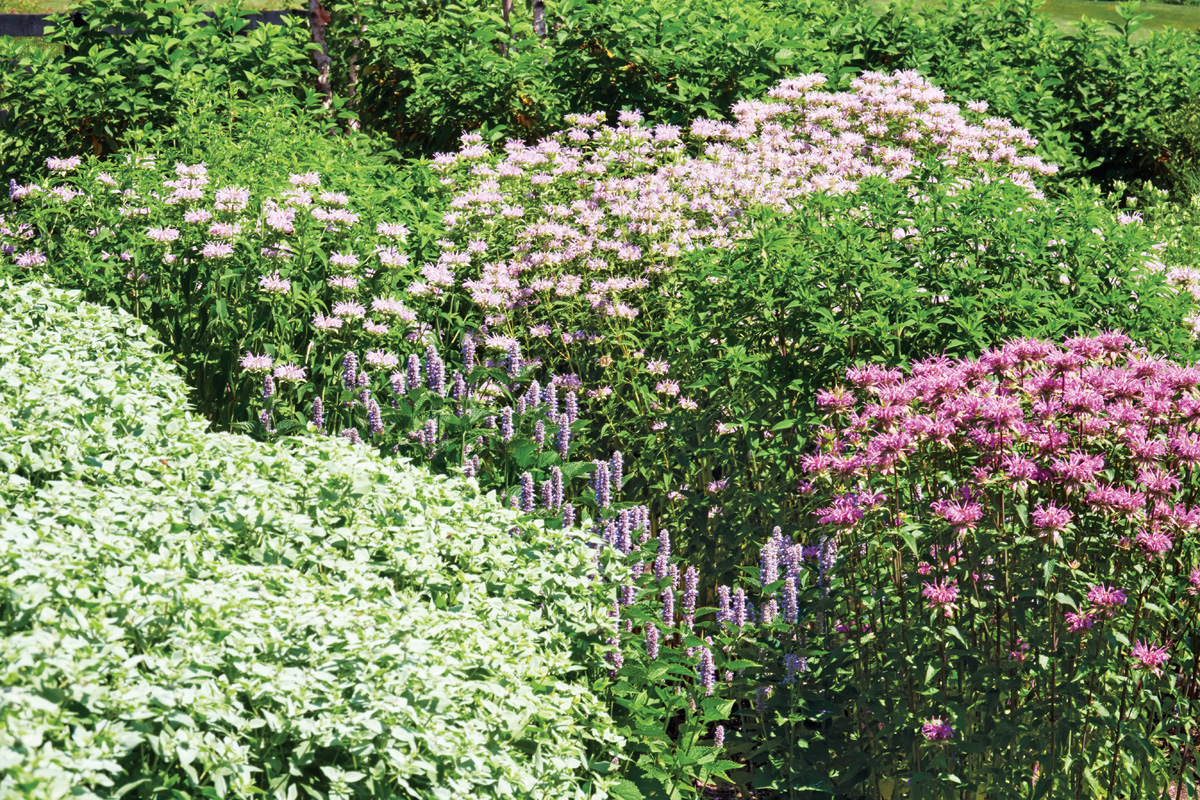
To prevent invasive species establishment from plants like Japanese honeysuckle (Lonicera japonica) and bittersweet (Celastrus orbiculatus), aggressive natives were brought in to outcompete them. Mountain mint (Pycnanthemum muticum, Zones 4–8) is a great choice for covering ground while providing incredible pollinator habitat. I combined that with wild bergamot (Monarda fistulosa, Zones 3–9) to stay within the color parameters given while creating lush flowering beds (photo p. 60, bottom). Anise hyssop (Agastache foeniculum, Zones 4–8) was also used in large tracts. This is a plant that freely reseeds itself; it was invaluable not only for its attractive blue flowers but its resiliency and toughness. A few non-native plant requests from the homeowner needed to be obliged as well. We kept a few of her favorite shrubs like hydrangeas (Hydrangea spp. and cvs., Zones 3–9), boxwoods (Buxus spp. and cvs., Zones 5–9), and some drift roses (Rosa spp. and cvs., Zones 3–10) (photo p. 60, top).
|
|
Build a sophisticated multi-season display with a mix of contrasting textures and forms
Principles of balance, repetition, and symmetry were used to help define the formality of the garden, with large matrix plantings and key combinations repeated throughout for consistency. A few specimen plants were also used to emphasize points of view. Woodies like a weeping eastern redbud (Cercis canadensis cv., Zones 4–8), white fringe tree (Chionanthus virginicus, Zones 3–9), and river birch (Betula nigra, Zones 4–9) were used as focal points (photo left).
Having some evergreen bones to the garden such as sweet bay magnolia (Magnolia virginiana, Zones 5–9) helped to define the form of the garden year-round when herbaceous plants had died back, and they also provided winter shelter for wildlife. But even those faded perennials contributed to the beauty. Feathery switchgrass looks stunning in the colder months next to buttonbush (Cephalanthus occidentalis, Zones 5–11) seed heads and the fruits of winterberry (Ilex verticillata, Zones 3–9). Strong textures from faded mountain mint contrasted well with the bright end-of-year foliage of threadleaf bluestar (Amsonia hubrichtii, Zones 5–9) (photos p. 62, top).
Reduced maintenance is key to achieving multiseason interest. Leaving herbaceous plants standing for winter extends the show, not to mention how beneficial it is for wildlife. Many of the plants chosen for this garden are rampant spreaders and self-seeders. While some editing can be done in a garden like this to maintain the more formal look of the matrix plantings, it’s important to realize that in a living landscape, plants will of course move around.
Bermed planting beds and rain gardens maximize functionality
To create privacy from the surrounding golf course, I brought in soil and mounded it around the edges of the property. This enabled me to create a design with varying heights, providing a natural-looking border without creating a complete barrier. All in all, roughly 1,000 tons of soil were brought in, then carefully shaped into berms, which were planted and mulched. The sculpting was gentle enough to make the berms rise and fall and look like a natural part of the landscape, blending in with their surroundings (photo right). The backyard became three-dimensional in the blink of an eye.
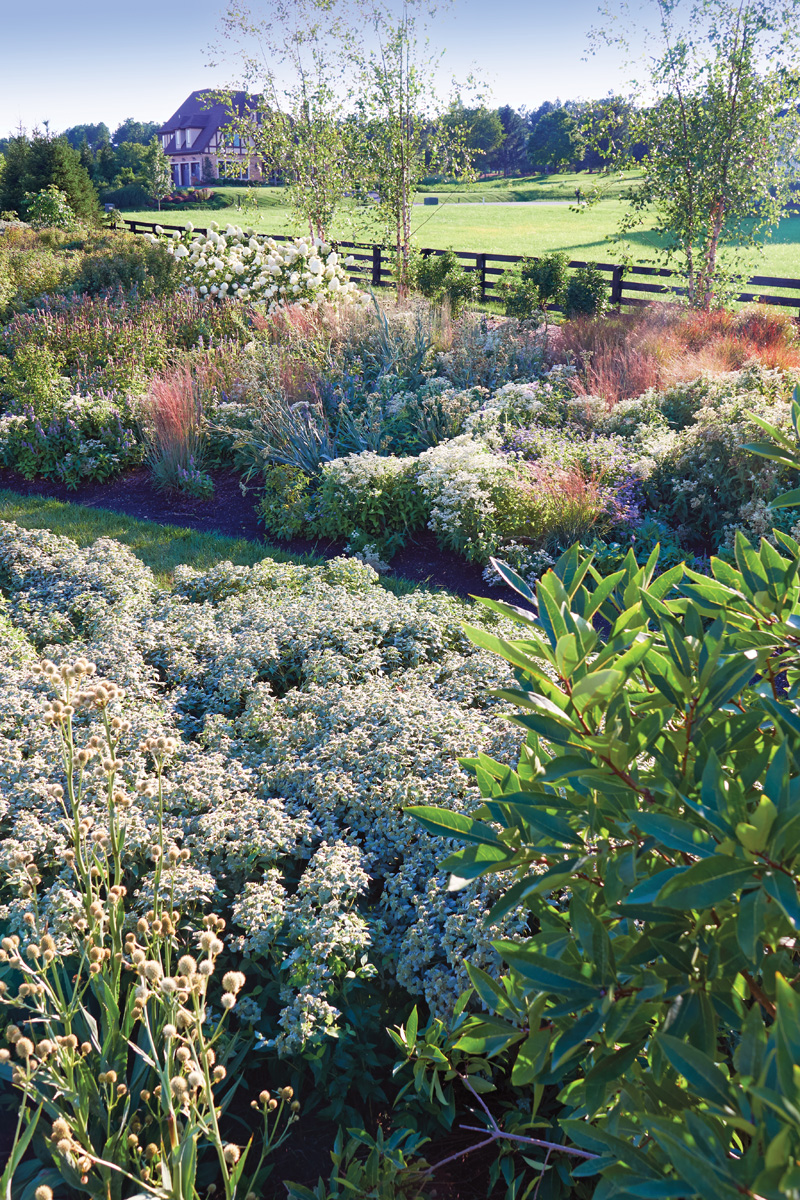
The slope of the land also made it easier to install rain gardens. In northern Virginia, where there are miles and miles of impervious surfaces in which water can pick up herbicides, pesticides, and other pollution before eventually draining into the Chesapeake Bay, adding rain gardens made sense. That way, stormwater could be largely contained on-site to foster adaptable native plants that can take moist soil and keep waterways cleaner. By piping rainwater runoff from the house’s roof into beds at the bottom of the property, it was possible to create a home for water-loving plants such as swamp rose mallow and buttonbush (photo top).
Native and eco-friendly does not have to mean messy and undisciplined. With specific design and construction choices, this garden provides year-round interest and privacy while also serving as a haven for wildlife.
| Technique |
The dos and don’ts of maintaining a pollinator garden
There can be a delicate balance between keeping up appearances while also maximizing sustainable practices with wildlife in mind. These tips allow you to get the most ecological benefit out of your garden while still maintaining a strong design.
John Magee is the owner and operator of Magee Design, a landscape design firm in Middleburg, Virginia.
Fine Gardening Recommended Products

FELCO F-2 068780 Classic Manual Hand Pruner, F 2, Red
Fine Gardening receives a commission for items purchased through links on this site, including Amazon Associates and other affiliate advertising programs.
Comfortable, lightweight, sturdy aluminium alloy handles. High quality hardened steel blades, forged aluminium alloy handles, wire cutting notch
Anvil blade with sap groove, rubber cushion shock aborbers. For a medium to large hand, right Handed; the handles have a non slip coating. Lifetime guarantee, all parts replaceable. Ideal pruner for light applications and easily adjustable. Features strong blades with a wire cutting notch. Lightweight metal handles. Blades are made of high-quality hardened steel. Limited lifetime warranty.

Fort Vee – Organic Potting Soil Mix
Fine Gardening receives a commission for items purchased through links on this site, including Amazon Associates and other affiliate advertising programs.
PRODUCT DETAILS: Vermont Compost Company Fort Vee Organic Potting Mix A rich, organic, compost-based potting soil that is ideal for growing your veggies, Plants, and herbs free from any harmful chemicals. Our all natural mixed organic garden soil is composed of all-natural ingredients our Plants needed to grow naturally and is a great choice for gardeners who prefer compost-based germination and growing medium. Product Weight: 20 Quarts

Organo Republic 16 Perennial Wildflower Seeds Mix for Indoor & Outdoors
Fine Gardening receives a commission for items purchased through links on this site, including Amazon Associates and other affiliate advertising programs.
Premium 16 Perennial Wildflower Seeds Mix – Special Garden Flower Seeds Blend designed for planting indoor & outdoors across North America. With over 16 varieties and 100,000 wildflower seeds, this mix is the best solution to attract pollinators – bees, butterflies & birds are essential for garden plants health. Our Special Perennial Wildflower Seeds Mix Includes White Yarrow, Columbine, New England Aster, Siberian Wallflower, Shasta Daisy, Lance-Leaf Coreopsis, Sweet William, Purple Coneflower, Blanketflower, Gayfeather, Blue Flax, Lupine, Dwarf Evening, Primrose, Mexican Hat, Prairie Coneflower, Black Eyed Susan. Easy & Fun Growing Experience with our online guides – Don’t plant disappointment – Add more colors to your wildflower garden! We send only super hearty heirloom flower seeds with the highest germination rate and fast sprout. Our detailed growing guide helps you grow seeds the garden of your dream like a PRO. Colorful Wildflower Garden from Seeds – Grow wildflowers everywhere – Indoor in window garden or Outdoors Flower garden Garden make a beautiful design for your garden borders, pathways, field or meadow and attract pollinators. Made in the USA by Small Family-Owned Business – Quality You Can Trust – Our wildflower bulk seeds variety pack are tested at the highest germination rates before being sealed to last for up to 3 years before you need to plant. Each packet of our flower seeds variety pack is resealable to make it easy to store and has its own label with a QR code for the growing instructions.

